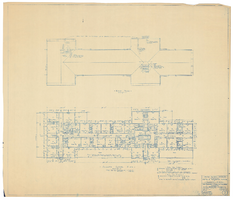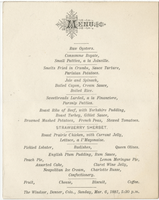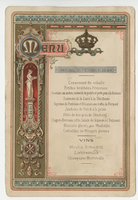Search the Special Collections and Archives Portal
Search Results

Roof and second floor plans for Los Angeles & Salt Lake Railroad hotel and passenger station in Caliente, Nevada: architectural drawing
Date
Archival Collection
Description
From Union Pacific Railroad Collection (MS-00397). The drawing shows the roof and second floor plans. Scales are noted on drawing. The bottom corner says "Union Pacific System. L.A. & S.L.R.R. Hotel & Passenger Station At Caliente, Nevada. John Parkinson & Donald B. Parkinson Architects. 420 Title Insurance Bldg., Los Angeles. Cal. Drawn R.D.M. Checked S.S.S. Traced R.D.M. Date 2-25-22. Scale 1/8" = 1'0". Job 162. Sheet 2. Revised 3-31-22. 4-25-22. 5-4-22."
Image

Windsor, menu, Sunday March 6, 1881
Date
Archival Collection
Description
Text

House of Savoy Royal Family residence, menu, February 25, 1884
Date
Archival Collection
Description
Text
Dorothy Ray Photograph Collection on Southern Nevada
Identifier
Abstract
The Dorothy Ray Photograph Collection on Southern Nevada, approximately 1900-1946, depicts infrastructure in Caliente, Nevada in the early to mid-twentieth century. The collection also contains images of a flash flood that occurred in 1905 in Carp, Nevada and Stine, Nevada that washed away roads and railroad tracks. This collection provides historical documentation about early to mid-century Caliente, Nevada.
Archival Collection
Fanny's Dress Shop Photographs
Identifier
Abstract
The Fanny’s Dress Shop Photographs (1930-1982) show one of Las Vegas’ premier women’s clothing stores. The collection includes images of Fanny Soss’ shop on Fremont Street, her store in the Flamingo Hotel, and Helldorado parades. Images include shop window displays.
Archival Collection
Patricia Becker Scrapbooks
Identifier
Abstract
The Patricia Becker Scrapbooks reflect the professional activities of "Patty" Becker from 1976 to 2013. Materials include photographs, awards, correspondence, and newspaper articles documenting Patricia Becker's career. Included are articles related to her appointment as the Executive Director of the UNLV International Gaming Institute in 2005 as well as a Harrah's Senior Executive Organization Chart from 1984 to 1993.
Archival Collection
Las Vegas Rotary Club Records
Identifier
Abstract
The Las Vegas Rotary Club Records (1981-2022) contain award certificates, club directories and rosters, Las Vegas Rotary publications, commemorative material including a 20-foot by 34-foot velvet curtain. The collection also contains plastic and metal Rotary Club signs from across the United States and international locations, material from a Rotary Club in Africa, and a digital video segment made in 2013 about the history of the Las Vegas Rotary.
Archival Collection
Ethlyn Barneby oral history interview
Identifier
Abstract
Oral history interview with Ethlyn Barneby conducted by Claytee White on October 16, 2002 for the Boyer Early Las Vegas Oral History Project. During this interview Barneby discusses her experiences as a resident of Boulder City, Nevada during the 1940s. Barneby also discusses life with her husband, a member of the National Guard, and her husband’s employment as an operator for the City of Los Angeles, California during the construction of the Hoover Dam. She also describes their experiences moving back and forth between Boulder City and Los Angeles as well as the growth of Boulder City in relation to Las Vegas, Nevada.
Archival Collection
Kaweeda Adams oral history interview
Identifier
Abstract
Oral history interview with Kaweeda Adams conducted by Kim Kershaw on March 05, 2004 for the Public School Principalship Oral History Project. In this interview, Adams reflects upon her career as a teacher in Louisiana from the 1980s to the 1990s, and as a teacher and administrator with Nevada’s Clark County School District (CCSD) from the 1990s to the early 2000s. She discusses her upbringing, and how her upbringing influenced her pursuit of education. She describes the process by which she became a teacher and eventually administrator, and compares her experiences working in Louisiana and Nevada. She discusses how these experiences shaped her philosophy of education, as well as changes that she has observed in the students over time. She describes her regular job duties, as well as challenges that she faced as a school administrator such as teacher dismissal and evaluations.
Archival Collection
Joan Olson Griffith oral history interview
Identifier
Abstract
Oral history interview with Joan Olson Griffith conducted by Sharee Schrader on April 12, 2005 for the History of Blue Diamond Village in Nevada Oral History Project. Griffith begins by discussing why she moved to Blue Diamond, Nevada with her family due to job opportunities at the Blue Diamond Plant, where they manufactured wallboard, in 1956. She describes life in Blue Diamond and rural Nevada, the education available in the village, and Blue Diamond's proximity to Bonnie Springs Ranch and structures made for the filming of Western themed media. Griffith concludes by discussing how Blue Diamond has changed since the 1950s and being a Sunday school teacher for eighteen years.
Archival Collection
